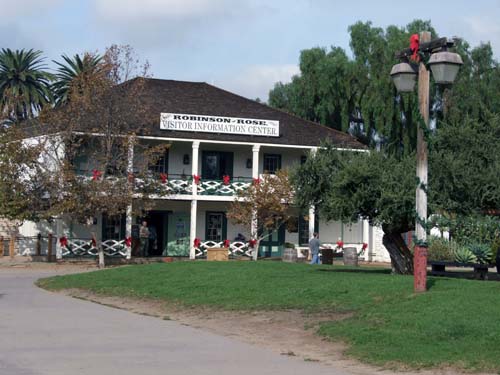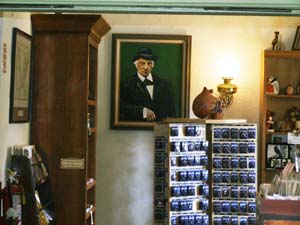
-Ninth in a Series-
Exit 3, Taylor Street, San Diego — Robinson-Rose House, Old Town San Diego State Historic Park

SAN DIEGO –The visitor information center on the plaza of Old Town San Diego State Historic Park is located within the two-story Robinson-Rose House, named for attorney James W. Robinson and businessman Louis Rose. Robinson lived in the house first, and after he died, Rose purchased it from Robinson’s widow, Sarah.
Rose had met the Robinsons in El Paso, Texas, when they joined the same wagon train en route to San Diego. They had to pass over the New Mexico, Arizona and California deserts, then navigate the Cuyamaca Mountains, before finally reaching San Diego County’s inland valleys and the small village of San Diego. Upon their arrival in 1850, San Diego had a population estimated at 650.
Robinson had served as lieutenant governor and as the disputed acting governor of the Provisional Government of Texas, created in 1835 when some Texans favored independence from Mexico, and others believed Texas should remain part of Mexico if the dictator Antonio Lopez de Santa Anna would restore constitutional protections that he abolished shortly after taking office.
In balloting, delegates to the Texas Consultation of 1835 elected Henry Smith as their provisional governor, and Robinson as their provisional lieutenant governor. However, Smith and the new Legislative Council didn’t get along, and before long the Legislative Council impeached Smith, while Smith meanwhile dissolved the Legislative Council. To replace Smith, the legislature picked Robinson to serve as the acting provisional governor. The net effect was that at a time when Texas was in mortal danger–for example, when Mexican troops had the Alamo under siege–the politicians of the Texas government were divided and fighting among themselves rather than rallying to the aid of the heroes inside the Alamo, who had to fight vainly against overwhelming odds. The Provisional Government’s term of office expired on March 1, 1836 when a Constitutional Convention met and decided to vote for independence, thereby creating the Republic of Texas.
When his term of office ended, Robinson enlisted as a private in the Texas Army that was being led by General Sam Houston. The general was impressed by Robinson’s willingness to fight as a common private, notwithstanding the high office he formerly had held. After Houston became Texas President, he named Robinson as a district court judge, a disastrous appointment. In one instance, Robinson ordered a defendant whipped before his lawyer could hear the verdict. In another case, the judge heard that friends of a defendant who was convicted in a capital case were planning to break him out of jail on the morning he was to be executed. So Robinson ordered the sheriff to hang the defendant that very night.
Robinson was persuaded to leave the bench, and to resume the private practice of law. He was at the courthouse in San Antonio during the Consultation of 1842, when Texas politicians tried to reach an accord with Comanche Indians. There was a war whoop, then arrows began to fly — one of them penetrating Robinson in the buttocks. Two years later, in 1844, Robinson was again at the courthouse when the Mexican General Adrian Wall captured him, other lawyers and judges who were there to conduct legal business.
Wall had them all marched to the Perote Prison in Vera Cruz, Mexico, where they were incarcerated. Robinson petitioned Santa Anna for a meeting, at which he offered to carry back to Sam Houston a proposal that Mexico would grant Texas autonomy if Texas would give up its independence and return to nominal Mexican citizenship. Santa Anna apparently figured he had nothing to lose, so sent Robinson back to Texas. The wily Houston wasn’t interested at all in giving up Texas independence, but used the proposal to begin negotiations with the Mexicans. He did so, believing correctly that the United States, which thus far had rejected Texas’s bid for admission as a new state, might be persuaded to act upon the petition rather than see Texas lost to Mexico.
While Houston was thankful for the opportunity to engage Mexico and the United States in negotiations, the populace of Texas turned against Robinson. Why was he free while his fellow captives continued to waste away in Perote Prison? Why would Robinson even discuss bargaining away Texas’s hard-fought independence? Although Robinson tried to resume his career as an attorney in Texas, his business dropped precipitously. He and his red-headed wife Sarah decided to move to California, where Robinson’s expertise in Mexican land law might be put to good use.
Rose had grown up in the German river town of Neuhaus-an-der-Oste, near where the Oste River and the mighty Elbe River flow into the North Sea. When he emigrated to the United States in 1840, he found in New Orleans another important city dependent on river commerce. He was married in New Orleans, but his initial business efforts were failures. Alone, he moved to Texas to try to make a fortune selling real estate. When he heard of the gold strike in California, and the many business opportunities there, he pushed on, writing to his wife that he would send for her when his financial situation allowed. His wife, the former Carolyn Marx, either did not receive the letter or chose to ignore it. When Rose, in fact, sent for his wife some years later, she had taken up with another man, and a divorce was arranged.
When the Robinsons met Rose on the wagon train, they saw him as a man who, though politically naive, had become astute in business. They had many discussions as the wagon train proceeded to San Diego. They enjoyed each other’s company. When the wagon train arrived in San Diego, word spread that three interesting personages had come to stay: Robinson, who had been a high official in Texas; his wife, Sarah, who was the first red-head many local residents had ever seen, and Rose, the first Jew to settle in San Diego. So who do you think created the greatest stir? Sarah, hands down. Men and women all wanted to feel her long red hair.
Robinson went about practicing land law, and eventually built himself the house on the Plaza. It was very different from the Mexican era dwellings in Old Town, such as the Casa de Estudillo on the other end of the Plaza. Whereas Robinson’s home was two stories, with windows looking out onto the Plaza and inviting people outside to look in, the Casa de Estudillo had walls protecting itself from the intrusive view of outsiders. Rooms were all accessed from an interior courtyard. Privacy and serenity were highly valued. Robinsons’ home on the other hand served both as a residence and a place of business. The downstairs was divided into areas for small businesses. Here were held meetings of the board of directors of the prospective San Diego and Gila Railroad, as well as of the membership of San Diego’s first Masonic Lodge. The Robinsons lived upstairs. There was a second floor terrace from which Mrs. Robinson could view and converse with passersby below.

Rose meanwhile rented the Casa de Reyes-Ybanez to serve as his Commercial Hotel and Saloon, it being located along present day Juan Street. While the hotel was far from luxurious, it was one of the first places that weary travelers from Los Angeles would notice as they rode into town.
The brand new City of San Diego almost immediately got itself into financial trouble. It decided to build a jail and asked for bids on the project. Agostin Haraszthy, the sheriff, whose father was a member of the Common Council, won the bidding, even though his bid was not the lowest. The jail he built became laughingly known as the “Swiss Cheese Jail of the West.” Almost anyone could get out of it. One of its early prisoners was Phantley Roy Bean, younger brother of San Diego’s first mayor Joshua Bean. Accused of arranging a duel, which was illegal in California, Bean did not wait around to be tried. He dug his way out of the jail, some say with a pocket knife, others say with a spoon. (Roy Bean later became a saloon-owner and justice of the peace in Langtry, Texas, where he styled himself “The Law West of the Pecos.”)
The embarrassed Sheriff Haraszthy said the condition of San Diego’s jail really was not his fault; he didn’t have the right building materials. But if the Common Council would vote him more money to make the repairs, he was certain he could obtain the necessary materials to make it better. The Council went along with the sheriff’s request, but didn’t have sufficient money to pay him. So it issued IOU’s in the form of $100 denomination bond notes. Anyone who purchased such a note would receive 8 percent interest a month! Unable to pay the bonds off, the Council’s inaction resulted in the bonds compounding each month, until the debt was so high there was no imaginable way for the Council to pay it off. At that point, the State of California revoked the city’s charter, and dissolved its Council. It then created a three member Board of Trustees which, under the state’s authority, should govern the town and find ways to pay off the bond debt.
A first Board of Trustees was elected but was unable to come up with solutions, so its members resigned. Robinson and Rose decided to run for the second board of trustees, and were elected along with William Ferrell. Robinson and Rose always voted together, and one might refer to their years in office as the Robinson-Rose era of San Diego politics. They first refused to pay the 8 percent interest on the bonds, and after the owners of the bonds sued them, an out-of-court settlement was reached that only 4 percent interest would be paid.
Thereafter, the trustees arranged for the city to auction off the Pueblo lands it had inherited from Mexico. Most people at the auction purchased lots in Old Town itself, but Robinson and Rose successfully bid for bayshore land lying between Old Town and the entrance to San Diego Bay. Additionally Rose purchased land in a canyon through which travelers from Los Angeles ordinarily would pass. Here he built a tannery, which served as a complementary business to the butcher shop he opened in Old Town. Rose also operated a general store in San Diego. The bayshore property Rose developed later as the town of Roseville, today part of the Point Loma community.
As members of the Board of Trustees, Rose and Robinson automatically became members of the first county Board of Supervisors organized in 1853. They laid out roads from San Diego to other cities, thereby affecting the area’s pattern of development for years to come. Rose also served as a volunteer in a U.S. military unit that sought to track down Antonio Garra, who led an Indian revolt against the new San Diego government. (Another unit found Garra and brought him back to San Diego for trial and execution.) Rose also served on the county’s first grand jury, and was a member of the school board.

Robinson died in 1857 and some years later Rose purchased the home from Sarah. Not only was it a residence for Rose, but it also was the venue for Jewish High Holy Day services and the formation of a Hebrew Benevolent Society. Among Rose’s deeds for the Jewish community were the transfer of land, at a nominal $5 price, for use as a Hebrew Cemetery. As a layman, he officiated at a Jewish wedding between Hyman Mannasse and Hannah Schiller.
A divorced man, Rose did not remarry until 1867, after friends promoted a union with the Jewish widow Mathilde Newman, whose husband had been a merchant. The couple had two daughters, one of whom died in infancy, and the other of whom became a spinster school teacher and a member of the Eastern Star Masonic organization. Mathilde died while Henrietta was still a child, and Rose, aging and blinding, entrusted her care to neighbors.
In commemoration of Rose’s ownership of the building–and to illustrate the religious diversity of San Diego’s pioneers — the administration of Old Town San Diego State Historic Park has hung a mezuzah on the inside door post of the auxiliary room of the Robinson-Rose House, a room that often had been used as a general store. Additionally on Chanukah, Jewish volunteers light the menorah at the home.
*
(Directions: From exit, follow Taylor Street to Juan Street, and turn left, park in one of the peripheral parking lots of Old Town San Diego State Historic Park and walk to the central plaza.)
Next: 2 Merchants’ Expanding Empire
Harrison is editor of San Diego Jewish World. You may comment to him at donald.harrison@sdjewishworld.com or post your comment on this website, provided that the rules below are observed.
__________________________________________________________________
Care to comment? We require the following information on any letter for publication: 1) Your full name 2) Your city and state (or country) of residence. Letters lacking such information will be automatically deleted. San Diego Jewish World is intended as a forum for the entire Jewish community, whatever your political leanings. Letters may be posted below provided they are responsive to the article that prompted them, and civil in their tone. Ad hominem attacks against any religion, country, gender, race, sexual orientation, or physical disability will not be considered for publication. There is a limit of one letter per writer on any given day.
__________________________________________________________________
Pingback: Divorce Center San Diego | divorce.showjewellerybox.org